16.7E : Exercices pour la section 16.7
- Page ID
- 197877
Dans les exercices 1 à 6, sans utiliser le théorème de Stokes, calculez directement à la fois le flux de\(curl \, \vecs F \cdot \vecs N\) sur la surface donnée et l'intégrale de circulation autour de sa limite, en supposant que toutes sont orientées dans le sens des aiguilles d'une montre.
1. \(\vecs F(x,y,z) = y^2\,\mathbf{\hat i} + z^2\,\mathbf{\hat j} + x^2\,\mathbf{\hat k}\);\(S\) est la première partie octante du plan\(x + y + z = 1\).
2. \(\vecs F(x,y,z) = z\,\mathbf{\hat i} + x\,\mathbf{\hat j} + y\,\mathbf{\hat k}\);\(S\) est un hémisphère\(z = (a^2 - x^2 - y^2)^{1/2}\).
- Réponse
- \(\displaystyle \iint_S (curl \, \vecs F \cdot \vecs N) \, dS = \pi a^2\)
3. \(\vecs F(x,y,z) = y^2\,\mathbf{\hat i} + 2x\,\mathbf{\hat j} + 5\,\mathbf{\hat k}\);\(S\) est un hémisphère\(z = (4 - x^2 - y^2)^{1/2}\).
4. \(\vecs F(x,y,z) = z\,\mathbf{\hat i} + 2x\,\mathbf{\hat j} + 3y\,\mathbf{\hat k}\);\(S\) est l'hémisphère supérieur\(z = \sqrt{9 - x^2 - y^2}\).
- Réponse
- \(\displaystyle \iint_S (curl \, \vecs F \cdot \vecs N) \, dS = 18 \pi\)
5. \(\vecs F(x,y,z) = (x + 2z)\,\mathbf{\hat i} + (y - x)\,\mathbf{\hat j} + (z - y)\,\mathbf{\hat k}\);\(S\) est une région triangulaire avec des sommets\((3, 0, 0), \, (0, 3/2, 0),\) et\((0, 0, 3).\)
6. \(\vecs F(x,y,z) = 2y\,\mathbf{\hat i} + 6z\,\mathbf{\hat j} + 3x\,\mathbf{\hat k}\);\(S\) est une partie du paraboloïde\(z = 4 - x^2 - y^2\) située au-dessus du\(xy\) plan.
- Réponse
- \(\displaystyle \iint_S (curl \, \vecs F \cdot \vecs N) \, dS = -8 \pi\)
Dans les exercices 7 à 9, utilisez le théorème de Stokes\(\displaystyle \iint_S (curl \, \vecs F \cdot \vecs N) \, dS\) pour évaluer les champs vectoriels et la surface.
7. \(\vecs F(x,y,z) = xy\,\mathbf{\hat i} - z\,\mathbf{\hat j}\)et\(S\) est la surface du cube\(0 \leq x \leq 1, \, 0 \leq y \leq 1, \, 0 \leq z \leq 1\), à l'exception de la face où\(z = 0\) et en utilisant le vecteur normal de l'unité extérieure.
8. \(\vecs F(x,y,z) = xy\,\mathbf{\hat i} + x^2 \,\mathbf{\hat j} + z^2 \,\mathbf{\hat k}\); et\(C\) est l'intersection du paraboloïde\(z = x^2 + y^2\) et du plan\(z = y\), et utilise le vecteur normal vers l'extérieur.
- Réponse
- \(\displaystyle \iint_S (curl \, \vecs F \cdot \vecs N) \, dS = 0\)
9. \(\vecs F(x,y,z) = 4y\,\mathbf{\hat i} + z \,\mathbf{\hat j} + 2y \,\mathbf{\hat k}\); et\(C\) est l'intersection de la sphère\(x^2 + y^2 + z^2 = 4\) avec le plan\(z = 0\), et en utilisant le vecteur normal vers l'extérieur.
10. Utilisez le théorème de Stokes pour évaluer\(\displaystyle \int_C \big[2xy^2z \, dx + 2x^2yz \, dy + (x^2y^2 - 2z) \, dz\big],\) où\(C\) se trouve la courbe donnée par\(x = \cos t, \, y = \sin t, \, 0 \leq t \leq 2\pi\), parcourue dans le sens de l'augmentation\(t.\)
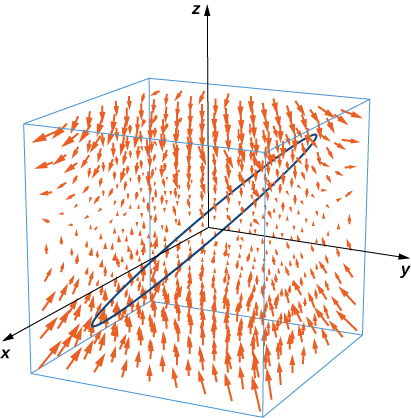
- Réponse
- \(\displaystyle \int_C \vecs F \cdot dS = 0\)
11. [T] Use a computer algebraic system (CAS) and Stokes’ theorem to approximate line integral \(\displaystyle \int_C (y \, dx + z \, dy + x \, dz),\) where \(C\) is the intersection of plane \(x + y = 2\) and surface \(x^2 + y^2 + z^2 = 2(x + y)\), traversed counterclockwise viewed from the origin.
12. [T] Use a CAS and Stokes’ theorem to approximate line integral \(\displaystyle \int_C (3y\, dx + 2z \, dy - 5x \, dz),\) where \(C\) is the intersection of the \(xy\)-plane and hemisphere \(z = \sqrt{1 - x^2 - y^2}\), traversed counterclockwise viewed from the top—that is, from the positive \(z\)-axis toward the \(xy\)-plane.
- Answer
- \(\displaystyle \int_C \vecs F \cdot dS = - 9.4248\)
13. [T] Use a CAS and Stokes’ theorem to approximate line integral \(\displaystyle \int_C [(1 + y) \, z \, dx + (1 + z) x \, dy + (1 + x) y \, dz],\) where \(C\) is a triangle with vertices \((1,0,0), \, (0,1,0)\), and \((0,0,1)\) oriented counterclockwise.
14. Use Stokes’ theorem to evaluate \(\displaystyle \iint_S curl \, \vecs F \cdot dS,\) where \(\vecs F(x,y,z) = e^{xy} cos \, z\,\mathbf{\hat i} + x^2 z\,\mathbf{\hat j} + xy\,\mathbf{\hat k}\), and \(S\) is half of sphere \(x = \sqrt{1 - y^2 - z^2}\), oriented out toward the positive \(x\)-axis.
- Answer
- \(\displaystyle \iint_S \vecs F \cdot dS = 0\)
15. [T] Use a CAS and Stokes’ theorem to evaluate \(\displaystyle \iint_S (curl \, \vecs F \cdot \vecs N) \, dS,\) where \(\vecs F(x,y,z) = x^2 y\,\mathbf{\hat i} + xy^2 \,\mathbf{\hat j} + z^3 \,\mathbf{\hat k}\) and \(C\) is the curve of the intersection of plane \(3x + 2y + z = 6\) and cylinder \(x^2 + y^2 = 4\), oriented clockwise when viewed from above.
16. [T] Use a CAS and Stokes’ theorem to evaluate \(\displaystyle \iint_S curl \, \vecs F \cdot dS,\) where \(\vecs F(x,y,z) = \left( \sin(y + z) - yx^2 - \dfrac{y^3}{3}\right)\,\mathbf{\hat i} + x \, \cos (y + z) \,\mathbf{\hat j} + \cos (2y) \,\mathbf{\hat k}\) and \(S\) consists of the top and the four sides but not the bottom of the cube with vertices \((\pm 1, \, \pm1, \, \pm1)\), oriented outward.
- Answer
- \(\displaystyle \iint_S curl \, \vecs F \cdot dS = 2.6667\)
17. [T] Use a CAS and Stokes’ theorem to evaluate \(\displaystyle \iint_S curl \, \vecs F \cdot dS,\) where \(\vecs F(x,y,z) = z^2\,\mathbf{\hat i} + 3xy\,\mathbf{\hat j} + x^3y^3\,\mathbf{\hat k}\) and \(S\) is the top part of \(z = 5 - x^2 - y^2\) above plane \(z = 1\) and \(S\) is oriented upward.
18. Use Stokes’ theorem to evaluate \(\displaystyle \iint_S (curl \, \vecs F \cdot \vecs N) dS,\) where \(\vecs F(x,y,z) = z^2\,\mathbf{\hat i} + y^2\,\mathbf{\hat j} + x\,\mathbf{\hat k}\) and \(S\) is a triangle with vertices \((1, 0, 0), \, (0, 1, 0)\) and \((0, 0, 1)\) with counterclockwise orientation.
- Answer
- \(\displaystyle \iint_S (curl \, \vecs F \cdot \vecs N)dS = -\dfrac{1}{6}\)
19. Use Stokes’ theorem to evaluate line integral \(\displaystyle \int_C (z \, dx + x \, dy + y \, dz),\) where \(C\) is a triangle with vertices \((3, 0, 0), \, (0, 0, 2),\) and \((0, 6, 0)\) traversed in the given order.
20. Use Stokes’ theorem to evaluate \(\displaystyle \int_C \left(\dfrac{1}{2} y^2 \, dx + z \, dy + x \, dz \right),\) where \(C\) is the curve of intersection of plane \(x + z = 1\) and ellipsoid \(x^2 + 2y^2 + z^2 = 1\), oriented clockwise from the origin.
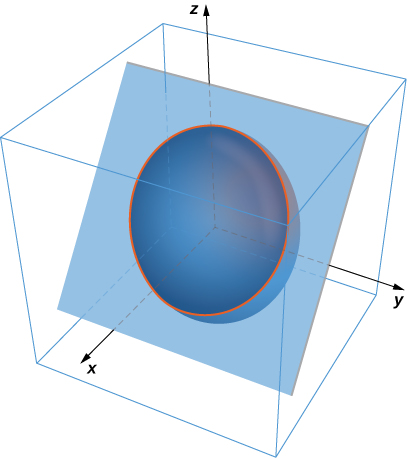
- Réponse
- \(\displaystyle \int_C \left(\dfrac{1}{2} y^2 \, dx + z \, dy + x \, dz \right) = - \dfrac{\pi}{4}\)
21. Utilisez le théorème de Stokes pour évaluer\(\displaystyle \iint_S (curl \, \vecs F \cdot \vecs N) dS,\) où\(\vecs F(x,y,z) = x\,\mathbf{\hat i} + y^2\,\mathbf{\hat j} + ze^{xy}\,\mathbf{\hat k}\) et\(S\) se trouve la partie de la surface\(z = 1 - x^2 - 2y^2\)\(z \geq 0\), orientée dans le sens antihoraire.
22. Utilisez le théorème de Stokes pour un champ vectoriel\(\vecs F(x,y,z) = z\,\mathbf{\hat i} + 3x\,\mathbf{\hat j} + 2z\,\mathbf{\hat k}\) où\(S\)\(C\) est une surface\(z = 1 - x^2 - 2y^2, \, z \geq 0\)\(x^2 + y^2 = 1\), un cercle limite et\(S\) est orienté dans la\(z\) direction positive.
- Réponse
- \(\displaystyle \iint_S (curl \, \vecs F \cdot \vecs N)dS = -3\pi\)
23. Utilisez le théorème de Stokes pour le champ vectoriel\(\vecs F(x,y,z) = - \dfrac{3}{2} y^2\,\mathbf{\hat i} - 2 xy\,\mathbf{\hat j} + yz\,\mathbf{\hat k}\), où\(S\) est la partie de la surface du plan\(x + y + z = 1\) contenue dans un triangle\(C\) avec des sommets\((1, 0, 0), \, (0, 1, 0),\) et\((0, 0, 1),\) parcourue dans le sens antihoraire vu de dessus.
24. Une certaine trajectoire fermée\(C\) dans le plan\(2x + 2y + z = 1\) est connue pour se projeter sur un cercle unitaire\(x^2 + y^2 = 1\) dans le\(xy\) plan. \(C\)Soyons une constante et laissez\(\vecs R(x,y,z) = x\,\mathbf{\hat i} + y\,\mathbf{\hat j} + z\,\mathbf{\hat k}\). Utilisez le théorème de Stokes pour évaluer\(\displaystyle \int_C(c \,\mathbf{\hat k} \times \vecs R) \cdot dS.\)
- Réponse
- \(\displaystyle \int_C (c \,\mathbf{\hat k} \times \vecs R) \cdot dS = 2\pi c\)
25. Utilisez le théorème de Stokes et laissez\(C\) être la limite de la surface\(z = x^2 + y^2\) avec la normale\(0 \leq y \leq 1\) orientée vers le haut\(0 \leq x \leq 2\) et orientée vers le haut. Définissez\(\vecs F(x,y,z) = \big(\sin (x^3) + xz\big) \,\mathbf{\hat i} + (x - yz)\,\mathbf{\hat j} + \cos (z^4) \,\mathbf{\hat k}\) et évaluez\(\int_C \vecs F \cdot dS\).
26. \(S\)Soit un hémisphère\(x^2 + y^2 + z^2 = 4\) avec\(z \geq 0\), orienté vers le haut. \(\vecs F(x,y,z) = x^2 e^{yz}\,\mathbf{\hat i} + y^2 e^{xz} \,\mathbf{\hat j} + z^2 e^{xy}\,\mathbf{\hat k}\)Soit un champ vectoriel. Utilisez le théorème de Stokes pour évaluer\(\displaystyle \iint_S curl \, \vecs F \cdot dS.\)
- Réponse
- \(\displaystyle \iint_S curl \, \vecs F \cdot dS = 0\)
27. Soit\(\vecs F(x,y,z) = xy\,\mathbf{\hat i} + (e^{z^2} + y)\,\mathbf{\hat j} + (x + y)\,\mathbf{\hat k}\) et\(S\) soit le graphe de la fonction\(z \leq 0\) orienté\(y = \dfrac{x^2}{9} + \dfrac{z^2}{9} - 1\) de telle sorte que le vecteur normal\(S\) ait une composante y positive. Utiliser le théorème de Stokes pour calculer l'intégrale\(\displaystyle \iint_S curl \, \vecs F \cdot dS.\)
28. Utilisez le théorème de Stokes pour évaluer\(\displaystyle \oint \vecs F \cdot dS,\) où\(\vecs F(x,y,z) = y\,\mathbf{\hat i} + z\,\mathbf{\hat j} + x\,\mathbf{\hat k}\) et\(C\) se trouve un triangle avec des sommets\((0, 0, 0), \, (2, 0, 0)\) et\(0,-2,2)\) orienté dans le sens antihoraire vu de dessus.
- Réponse
- \(\displaystyle \oint \vecs F \cdot dS = -4\)
29. Utilisez l'intégrale de surface du théorème de Stokes pour calculer la circulation du champ\(\vecs F,\)\(\vecs F(x,y,z) = x^2y^3 \,\mathbf{\hat i} + \,\mathbf{\hat j} + z\,\mathbf{\hat k}\) autour\(C,\) duquel se trouve l'intersection du cylindre\(x^2 + y^2 = 4\) et de l'hémisphère\(x^2 + y^2 + z^2 = 16, \, z \geq 0\), orientée dans le sens antihoraire vu de dessus.
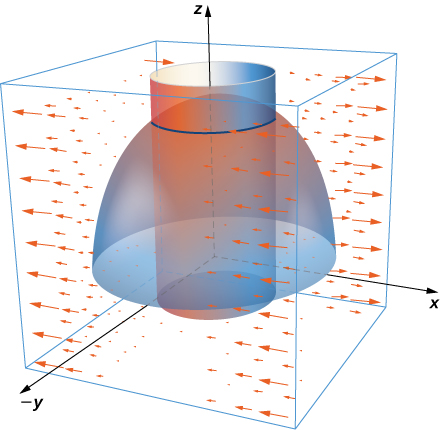
30. Utilisez le théorème de Stokes pour calculer\(\displaystyle \iint_S curl \, \vecs F \cdot dS.\) where \(\vecs F(x,y,z) = \,\mathbf{\hat i} + xy^2\,\mathbf{\hat j} + xy^2 \,\mathbf{\hat k}\) and \(S\) is a part of plane \(y + z = 2\) inside cylinder \(x^2 + y^2 = 1\) and oriented counterclockwise.
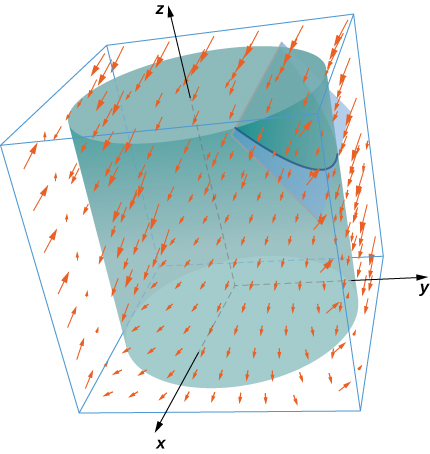
- Réponse
- \(\displaystyle \iint_S curl \, \vecs F \cdot dS = 0\)
31. Utilisez le théorème de Stokes pour évaluer\(\displaystyle \iint_S curl \, \vecs F \cdot dS,\) où\(\vecs F(x,y,z) = -y^2 \,\mathbf{\hat i} + x\,\mathbf{\hat j} + z^2\,\mathbf{\hat k}\) et\(S\) est la partie du plan\(x + y + z = 1\) dans l'octant positif et orientée dans le sens antihoraire\(x \geq 0, \, y \geq 0, \, z \geq 0\).
32. \(C\)Soit\(\vecs F(x,y,z) = xy\,\mathbf{\hat i} + 2z\,\mathbf{\hat j} - 2y\,\mathbf{\hat k}\) l'intersection du plan\(x + z = 5\) et du cylindre\(x^2 + y^2 = 9\), qui est orientée dans le sens antihoraire lorsqu'on la regarde depuis le haut. Calculez l'intégrale linéaire de\(\vecs F\) over\(C\) à l'aide du théorème de Stokes.
- Réponse
- \(\displaystyle \iint_S curl \, \vecs F \cdot dS = -36 \pi\)
33. [T] Utilisez un CAS et laissez\(\vecs F(x,y,z) = xy^2\,\mathbf{\hat i} + (yz - x)\,\mathbf{\hat j} + e^{yxz}\,\mathbf{\hat k}\). Utilisez le théorème de Stokes pour calculer l'intégrale de surface de la courbure\(\vecs F\) sur\(S\) une surface orientée vers l'intérieur constituée d'un cube\([0,1] \times [0,1] \times [0,1]\) dont le côté droit est absent.
34. \(S\)Soit un ellipsoïde\(\dfrac{x^2}{4} + \dfrac{y^2}{9} + z^2 = 1\) orienté dans le sens antihoraire et\(\vecs F\) soit un champ vectoriel avec des fonctions constitutives qui ont des dérivées partielles continues.
- Réponse
- \(\displaystyle \iint_S curl \, \vecs F \cdot \vecs N = 0\)
35. Que\(S\) vous fassiez partie du paraboloïde\(z = 9 - x^2 - y^2\) avec\(z \geq 0\). Vérifiez le théorème de Stokes pour le champ vectoriel\(\vecs F(x,y,z) = 3z\,\mathbf{\hat i} + 4x\,\mathbf{\hat j} + 2y\,\mathbf{\hat k}\).
36. [T] Utilisez un CAS et le théorème de Stokes pour évaluer\(\displaystyle \oint \vecs F \cdot dS,\) si\(\vecs F(x,y,z) = (3z - \sin x) \,\mathbf{\hat i} + (x^2 + e^y) \,\mathbf{\hat j} + (y^3 - \cos z) \,\mathbf{\hat k}\) et où\(C\) est la courbe donnée par\(x = \cos t, \, y = \sin t, \, z = 1; \, 0 \leq t \leq 2\pi\).
- Réponse
- \(\displaystyle \oint_C \vecs F \cdot d\vecs{r} = 0\)
37. [T] Utilisez un CAS et le théorème de Stokes pour évaluer\(\vecs F(x,y,z) = 2y\,\mathbf{\hat i} + e^z\,\mathbf{\hat j} - \arctan x \,\mathbf{\hat k}\) avec\(S\) une portion de paraboloïde\(z = 4 - x^2 - y^2\) coupée par le\(xy\) plan orienté dans le sens antihoraire.
38. [T] Utilisez un CAS pour évaluer la\(\displaystyle \iint_S curl (F) \cdot dS,\) position\(\vecs F(x,y,z) = 2z\,\mathbf{\hat i} + 3x\,\mathbf{\hat j} + 5y\,\mathbf{\hat k}\) et la\(S\) position de la surface de manière paramétrique\(\vecs r(r,\theta) = r \, \cos \theta \,\mathbf{\hat i} + r \, \sin \theta \,\mathbf{\hat j} + (4 - r^2) \,\mathbf{\hat k} \, (0 \leq \theta \leq 2\pi, \, 0 \leq r \leq 3)\).
- Réponse
- \(\displaystyle \iint_S curl (F) \cdot dS = 84.8230\)
39. \(S\)Soyons paraboloïdes\(z = a (1 - x^2 - y^2)\)\(z \geq 0\), car où se\(a > 0\) trouve un vrai nombre. Laissez\(\vecs F(x,y,z) = \langle x - y, \, y + z, \, z - x \rangle\). Pour quelle (s) valeur (s) de\(a\) (le cas échéant)\(\displaystyle \iint_S (\vecs \nabla \times \vecs F) \cdot \vecs n \, dS\) a sa valeur maximale ?
Pour les exercices d'application 40 à 41, l'objectif est d'évaluer\(\displaystyle A = \iint_S (\vecs \nabla \times \vecs F) \cdot \vecs n \, dS,\) où\(\vecs F = \langle xz, \, -xz, \, xy \rangle\) et\(S\) se trouve la moitié supérieure de l'ellipsoïde\(x^2 + y^2 + 8z^2 = 1\), où\(z \geq 0\).
40. Évaluez une intégrale de surface sur une surface plus pratique pour trouver la valeur de\(A.\)
- Réponse
- \(\displaystyle A = \iint_S (\vecs \nabla \times \vecs F) \cdot \vecs n \, dS = 0\)
41. Évaluez\(A\) à l'aide d'une intégrale linéaire.
42. Prenez du paraboloïde\(z = x^2 + y^2\), formez\(0 \leq z \leq 4\), et tranchez-le avec de l'avion\(y = 0\). \(S\)Soit la surface qui reste pour\(y \geq 0\), y compris la surface plane dans le\(xz\) plan. \(C\)Soit le demi-cercle et le segment de ligne qui délimitaient le sommet d'un plan\(z = 4\) orienté\(S\) dans le sens antihoraire. Laissez\(\vecs F = \langle 2z + y, \, 2x + z, \, 2y + x \rangle\). Évaluer\(\displaystyle \iint_S (\vecs \nabla \times \vecs F) \cdot \vecs n \, dS.\)
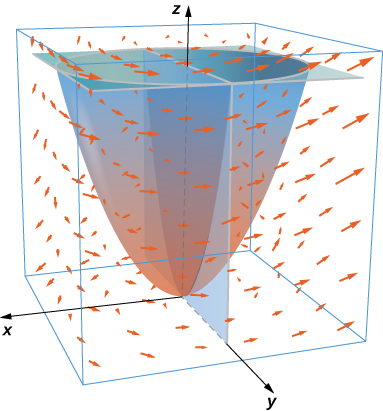
- Réponse


